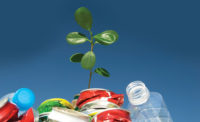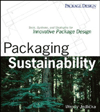Spotlight Feature
Advances in Packaging Sustainability
Brands are telling their truth with new sustainable initiatives.

In January, U.S. plastic bag manufacturers and recyclers signed a sustainability commitment for the industry and renamed its coalition the American Recyclable Plastic Bag Alliance (ARPBA). The agreement by ARPBA members includes a target that 95% of plastic retail bags be reused or recycled by 2025.
A report by Evergreen Packaging, based on data from the annual EcoFocus Trends Survey, reveals an emphasis on sustainability by millennials. But that’s not all.
The survey also forecasts key trends that will shape the U.S. food and beverage industries in the future. In this iteration, it examines how consumer attitudes, preferences and values are reshaping grocery purchasing decisions.
According to President and CEO of EcoFocus, Linda Gilbert, millennials have taken the lead on the sustainable packaging conversation with the expectation that brand owners will do their part to deliver eco-friendly solutions.
“Millennials will reward and be loyal to companies who make commitments to what they see as desirable behavior. And they are willing to boycott companies who behave poorly or act opportunistically,” Gilbert said.
The survey shows that more than 8 out of 10 shoppers agree that being ecofriendly is “common sense.” While millennials are on par with other consumers on these issues, what sets them apart is that 64% of them say that “to them it is worth paying more for ecofriendly products,” compared to just 38% of Baby Boomers.
Here are five key beliefs showing how millennials will impact sustainable packaging forever:
- A healthier planet means a healthier me
- Healthier foods & beverages are even healthier in sustainable packaging
- Food & beverages need to come in packaging that supports sustainable practices
- Brand owners will build trust by acting more responsibly toward the environment
- It is worth paying more for eco-friendly products
For the full whitepaper, visit evergreenpackaging.com.
Sustainability in Materials
There are several packaging materials that offer sustainability — from biodegradable and compostable to reusable and recyclable. Here are just a few that stand out.
One of the most used packages in pharmaceuticals is the blister pack, which is known for its tough, rigid structure. Until now.
Sonoco Alloyd recently introduced an all-paper alternative to plastic blister packaging. The new EnviroSense PaperBlister™ provides an alternative to the more traditional thermoformed plastic blister package that is found prominently in retail outlets around the world.
The EnviroSense PaperBlister features a variety of attributes designed with the environment in mind. It’s plastic-free and recyclable in the paper stream and is also available with SFI™ certification when requested. Because it uses water-based sealing technology, there are no VOCs connected with the package. The new paper blister packs deliver more efficiency than traditional plastic blister products, which require three times more shipping cartons, leading to increased weight, more packaging material, fewer packages per truckload and more deliveries to ship the same amount of product.
One of the finalists of the Sustainable Packaging Coalition’s Protective Packaging Design Challenge, Cruz Foam is changing the game for sustainable materials used in protective packaging.
CruzFoam created a range of compostable packaging materials by combining the seafood industry waste stream (shrimp shells sourced from sustainable farming) with the overflow waste stream from paper recycling, transforming them into a naturally sourced foam. CruzFoam has comparable mechanical properties and thermal insulation to expanded polystyrene and at scale, has promise to be cost-competitive.
The product range can offer consumer packaging and shipping materials utilizing industry standard, scalable processes including thermoforming, die cutting and three-dimensional molded parts.
New Barn Organics is one brand that is already using eco-friendly materials. The plant-based brand is transitioning its Almondmilk line, previously packaged in plastic, to Evergreen’s PlantCarton™ paper packaging. The PlantCarton brand is part of Evergreen Packaging’s commitment to sustainability with an emphasis on the importance of using renewable materials in packaging.
“At New Barn Organics, we are dedicated to organic and the environmental responsibility that comes with it,” said Ted Robb, CEO of New Barn Organics. “We heard clearly from our customers that a transition to plant-based packaging versus petroleum-based packaging is right for our brand and right for our products. And since a key premise of our business is to be transparent with our ingredients and sourcing decisions, we are dedicating space on a panel of the cartons to the PlantCarton story.”
Evergreen’s PlantCarton packages are made with at least 70% renewable material; paper made from trees where responsible forestry practices are used. Evergreen Packaging also offers other sustainable solutions such as renewable cupstock and ice cream board.
The SKIN SAPIENS skincare range presents three products for babies: a lotion, bath gel and balm, as well as three for adults: a facial cleansing gel, face cream and a vegan lip balm. The brand was a project that began 18 months ago in a kitchen in Madrid, Spain.
The brand chose Lewis Moberly as a design consultancy. The identity, which economically drives the brand is, like the product, edited, pared down and pure in form. Packaging designs are equally simple. The back of pack product information was replaced with straightforward information showcased on the front. The color palette was inspired by mineral shades found in nature, but is also pale enough to allow the bottles to be recycled. In fact, the bottles are made entirely from recycled British drinks bottles, so the loop is closed. The design shows how a brand can powerfully point to a product’s sustainability.
Sustainability in Labeling
Michael LeRoy, senior product manager, Prime Paper, Avery Dennison Label and Packaging Materials, shares insight into sustainability with labels.
Today’s consumers demand sustainability not only in their products, but the packaging as well. Product quality and price are still important, but consumers in 2020 — led by millennials — take packaging sustainability into account when making a purchase, according to Avery Dennison research.
The good news: Brands are responding. Many brands have a sustainability story to tell, and part of that story is packaging — how the packaging material was sourced, its recyclability and how it fits within the brand’s overall carbon footprint. But even sustainable packaging faces challenges.
Packaging is faced with a paradox — demand for recycling and sustainability has never been greater but the ability for packaging to be recycled is more difficult than ever. Brand owners are working with packaging designers, labeling manufacturers and converters to achieve sustainable packaging that is itself sustainable — a solution that can weather the twists and turns in the ever-changing world that is recycling.
Labels can offer key features that reduce the amount of raw goods required in packaging while taking advantage of materials that are recycled, create less waste or enable recycling.
Examples include:
Using recycled materials, such as rPET from bottles, to make up a portion of the label liner (liners back die-cut labels and release the adhesive-backed label to the product). Avery Dennison recently launched its rPET liner for semi-gloss paper face stocks with a liner made from more than 30% post-consumer waste. The first of its kind in North America, it delivers the same converting and dispensing performance as traditional liners and reduces the need to use new resources. It also lessens the amount of water, energy, fossil materials and greenhouse gases used in the manufacturing process.
Some applications can take advantage of a new technology that eliminates the liner altogether, employing a thin release face-stock coating that prevents the adhesive from sticking to the layer beneath. This reduces the amount of material used and translates to labor savings for the converter. No liner means thinner label rolls, and that means savings in fuel and shipping.
Products like produce or bakery, often offered in clamshells or trays with lids, can now take advantage of heat-resealable reclosure systems that replace plastic lids with a peel-reseal film welded to a tray. The film and adhesive properties can be designed to meet a wide range of performance characteristics including:
- venting and barrier properties to optimize shelf life and content freshness
- seal strength and water resistance levels to deliver excellent user experience.
These systems have a significant positive impact on sustainability since they reduce the plastic content by up to 40% versus a plastic clamshell or tray with lid.
Labels can also enhance a PET containers’ recyclability. They can even give it a better chance of being recycled into food grade rPET, fully capitalizing on the renewable energy of a PET bottle. To enhance a container’s chances of being recycled throughout the value chain, Avery Dennison offers its CleanFlake™ Portfolio of labeling solutions. CleanFlake adhesive technology cleanly separates in the recycling processes’ caustic bath, and leaves no adhesive residue on the resulting PET flake — a winning proposition for all.
See what Avery Dennison has to offer at avery-dennison.com.
Sustainability in Design
Isabel Valero Iglesias, program manager at Adept Packaging, reveals how to choose the right design for sustainability.
More than ever packaging design is in the eye of the storm. Plastic production has been steadily increasing over the last 40 years, with packaging now representing 42% of the total amount.
Across industries, brand owners are recognizing that plastics present a problem. In addition to the exponential increase in production, the general non-biodegradability and eventual toxicity of some of them represent challenges that need to be remedied.
In the meantime, solutions are being developed to combat the problem, but many of them present their own challenges, including high cost, which might prevent stakeholders from implementing them.
Choosing the right design for sustainability involves companies taking the time to understand their current position; evaluating the factors in their current packaging system that are misaligned with their sustainability goals, and then (re)designing with intent.
Conducting a Life Cycle Assessment (LCA), which is the first step to choosing the right design for sustainability, requires companies to thoroughly evaluate the life cycle of a product from cradle to grave, or more desirably cradle to cradle. This requires collaboration of internal and external stakeholders and a consist methodology to evaluate the functional units of the business/activity/process. Each unit has its own inputs and outputs in the form of energy, water, raw materials (inputs) and waste, emissions, etc. (outputs), which all impact overall sustainability.
The output from the LCA will allow companies to identify their current standing regarding sustainability goals and determine priorities based on which actions would have the greatest impact toward those goals (i.e. package redesign, substitution, etc.).
Utilizing the results from the LCA, an action plan can be developed for intentional design, especially for new product development. This means designing in a fashion that not only takes into account marketing, financial and/or operational needs, but the whole life cycle of the package as well. Some tips for intentional design:
- Consider using one material for the whole package
- Adapt the size of the packaging to the content (package-to-product ratio)
- Use packaging strategies to help maximize consumption of the content
- If possible, avoid gluing and lamination
- Design for recyclability
- Design for distribution
- To reduce set up times, design for assembly at manufacturer
- Design for disassemble and separation of component at consumer level
- Inform clearly about the recyclability of your packaging
- Consider use of materials from renewable raw materials
- Reevaluate supplier choices to leverage innovative materials and designs
Combining these tips for intentional design will help companies develop a more sustainable package. Incorporating this approach to sustainable packaging into the core business model will allow companies to enact real long-term change and avoid Greenwashing.
The Adept Group delivers best-in-class engineering, consulting, talent and digital solutions for packaging. adeptpackaging.com
Looking for a reprint of this article?
From high-res PDFs to custom plaques, order your copy today!











